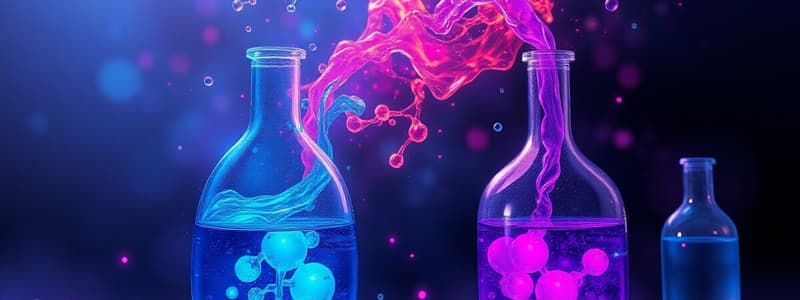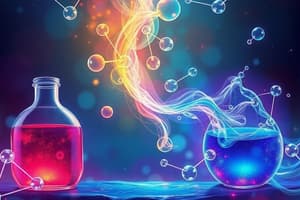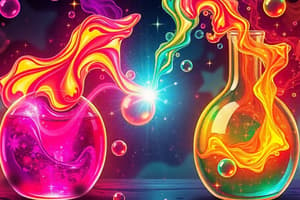Podcast
Questions and Answers
Acids have a pH value above 7.
Acids have a pH value above 7.
False (B)
What ions are formed when alkalis are added to water?
What ions are formed when alkalis are added to water?
- Hydroxide ions (OH-) (correct)
- Hydrogen ions (H+)
- Sodium ions (Na+)
- Chloride ions (Cl-)
A base that is water-soluble is referred to as an ______.
A base that is water-soluble is referred to as an ______.
alkali
Match the following pH ranges with their corresponding acidity or alkalinity:
Match the following pH ranges with their corresponding acidity or alkalinity:
Litmus paper turns which colour in basic conditions?
Litmus paper turns which colour in basic conditions?
All reactions of acids are neutralisation reactions.
All reactions of acids are neutralisation reactions.
What is the net ionic equation of all acid-base neutralizations?
What is the net ionic equation of all acid-base neutralizations?
What two products are formed when acids react with metals?
What two products are formed when acids react with metals?
Litmus is suitable for titrations because of its sharp colour change.
Litmus is suitable for titrations because of its sharp colour change.
Acids react with metal carbonates to form salt, water and ______.
Acids react with metal carbonates to form salt, water and ______.
Which of the following is an example of a strong acid?
Which of the following is an example of a strong acid?
What type of chemical reaction occurs when acids reacts with metal oxides?
What type of chemical reaction occurs when acids reacts with metal oxides?
What does it mean for an acid to be 'diprotic'?
What does it mean for an acid to be 'diprotic'?
A concentrated solution of a weak acid will always be more acidic than a dilute solution of a strong acid.
A concentrated solution of a weak acid will always be more acidic than a dilute solution of a strong acid.
Ammonium salts undergo ______ when warmed with an alkali.
Ammonium salts undergo ______ when warmed with an alkali.
What type of oxide is formed when a non-metal element combines with oxygen?
What type of oxide is formed when a non-metal element combines with oxygen?
What is the key difference between a strong acid and a weak acid in terms of ionisation in water?
What is the key difference between a strong acid and a weak acid in terms of ionisation in water?
In a reaction between hydrochloric acid and magnesium carbonate (MgCO3) what are the products?
In a reaction between hydrochloric acid and magnesium carbonate (MgCO3) what are the products?
All metal oxides and hydroxides (alkalis) behave as bases.
All metal oxides and hydroxides (alkalis) behave as bases.
The pH scale is ______, meaning that each change of 1 on the scale represents a change in concentration by a factor of 10.
The pH scale is ______, meaning that each change of 1 on the scale represents a change in concentration by a factor of 10.
Flashcards
Acids
Acids
Substances that neutralize bases, have a pH below 7, sour taste, and are corrosive.
Hydrogen ions (H+)
Hydrogen ions (H+)
Positively charged ions that acids form when added to water, making the solution acidic.
Acid + Metal Reaction
Acid + Metal Reaction
Reaction where acid and metal combine forming salt and hydrogen gas.
Neutralisation reaction
Neutralisation reaction
Signup and view all the flashcards
Salt, Carbon Dioxide, Water
Salt, Carbon Dioxide, Water
Signup and view all the flashcards
Indicators
Indicators
Signup and view all the flashcards
Alkalis
Alkalis
Signup and view all the flashcards
Hydroxide ions (OH-)
Hydroxide ions (OH-)
Signup and view all the flashcards
Neutral solutions
Neutral solutions
Signup and view all the flashcards
pH scale
pH scale
Signup and view all the flashcards
Acids
Acids
Signup and view all the flashcards
Strong acids
Strong acids
Signup and view all the flashcards
Weak acids
Weak acids
Signup and view all the flashcards
Oxide
Oxide
Signup and view all the flashcards
Acidic oxides
Acidic oxides
Signup and view all the flashcards
Basic oxides
Basic oxides
Signup and view all the flashcards
Amphoteric oxides
Amphoteric oxides
Signup and view all the flashcards
Neutral oxides
Neutral oxides
Signup and view all the flashcards
Study Notes
Properties of Acids
- Acids have a pH below 7 and a sour taste, and are corrosive.
- These neutralize bases to produce salt and water.
- Acids in water form positively charged hydrogen ions (H⁺).
- The presence of H⁺ ions makes a solution acidic.
- An example of this is hydrochloric acid: HCl (aq) → H⁺ (aq) + Cl⁻ (aq).
Acids and Metals
- Only metals above hydrogen in the reactivity series react with dilute acids.
- Metal and acid produce salt and hydrogen gas.
- The salt name depends on the anion within the acid used in in the reaction.
- Hydrochloric acid reacts with magnesium to produce magnesium chloride and hydrogen: Mg + 2HCl → MgCl₂ + H₂
- Sulfuric acid and magnesium react to form magnesium sulfate and hydrogen: Mg + H₂SO₄ → MgSO₄ + H₂
- Nitric acid and magnesium produce magnesium nitrate and hydrogen: Mg + 2HNO₃ → Mg(NO₃)₂ + H₂
Acids and Bases
- Metal oxides and metal hydroxides (alkalis) can act as bases.
- Neutralization occurs when they react with acids.
- Salt and water are produced in acid-base neutralization reactions.
- In general, acid + base → salt + water.
- Hydrochloric acid with magnesium chloride produces magnesium chloride and water: Mg(OH)₂ + 2HCl → MgCl₂ + 2H₂O
- Magnesium sulfate and water are produced from sulfuric acid and magnesium sulfate: MgO + H₂SO₄ → MgSO₄ + H₂O.
- Magnesium nitrate and water are produced from nitric acid with magnesium nitrate: Mg(OH)₂ + 2HNO₃ → Mg(NO₃)₂ + 2H₂O.
Acids with Metal Carbonates
- The corresponding metal salt, carbon dioxide, and water are produced when acids react with metal carbonates.
- acid + metal carbonate → salt + carbon dioxide + water
- Magnesium chloride, carbon dioxide, and water forms when hydrochloric acid reacts with a magnesium carbonate: MgCO₃ + 2HCl → MgCl₂ + CO₂ + H₂O
- Sulfuric acid reacts with magnesium carbonate to form magnesium sulfate, carbon dioxide, and water: MgCO₃ + H₂SO₄ → MgSO₄ + CO₂ + H₂O
- Magnesium nitrate, carbon dioxide, and water produced from reaction of nitric acid with magnesium carbonate: MgCO₃ + 2HNO₃ → Mg(NO₃)₂ + CO₂ + H₂O
Indicators
- Used to distinguish between acids and alkalis with two-colour indicators.
- Litmus is the most common indicator extracted from lichens in many plants.
- Appear in different colors in acids and alkalis, synthetic indicators are organic compounds.
- Thymolphthalein and methyl orange are often used as synthetic indicators in acid-alkali titrations.
- Litmus turns red in acid and blue in alkali.
- Methyl orange shows red in acid and yellow in alkali.
- Thymolphthalein is colorless in acid but turns blue in alkali.
Synthetic Indicators
- Synthetic indicators are used to identify the endpoint in titrations because they have distinct color changes when an acid is neutralized by alkali and vice versa.
- Because its color transition is not sharp and travels through a purple transition color in neutral solutions, litmus is unsuitable for titrations because endpoint detection is challenging.
- In the form of red and blue papers that can be dipped into solutions or used to test gases, litmus is helpful as an indicator paper.
Properties of Bases and Alkalis
- Bases’ pH values are above 7.
- Alkali refers to a base that dissolves in water.
- In basic conditions:
- Red litmus paper turns blue.
- Methyl orange indicator turns yellow.
- Thymolphthalein indicator turns blue.
- Acids can be neutralized by bases, which create salt and water.
- Metals' oxides or hydroxides are frequently the basis.
- Water is added to alkalis to create negative hydroxide ions (OH-).
- The presence of OH- ions makes the aqueous solution an alkali.
- For instance, sodium hydroxide: NaOH (s) → Na+ (aq) + OH- (aq).
Acids and Bases Reactions
- When bases react with an acid, neutralisation occurs.
- Acids and bases combine and produce salt and water.
- In general: Acid + base → salt + water
- Hydrochloric acid reacts with magnesium chloride to form magnesium chloride and water: Mg(OH)₂ + 2HCl → MgCl₂ + 2H₂O
- Magnesium sulfate and water are produced from sulfuric acid and magnesium sulfate: MgO + H₂SO₄ → MgSO₄ + H₂O.
- Magnesium nitrate and water are produced from nitric acid and magnesium nitrate: Mg(OH)₂ + 2HNO₃ → Mg(NO₃)₂ + H₂O
Alkalis and Ammonium Salts
- When warmed with an alkali, ammonium salts decompose.
- Even though ammonia is a weak base, it can easily be displaced from the salt by another alkali because it is volatile.
- Where a salt, water, and ammonia are produced, for example: NH₄Cl + NaOH → NaCl + H₂O + NH₃
- To check for the presence of the ammonium ion (NH₄⁺), use this reaction as a chemical test.
- Test for ammonia gas using wet red litmus paper after alkali has been added to the substance and gently warmed.
- The damp litmus paper turns from red to blue if ammonia is present.
Neutralization Reactions
- Acids provide hydrogen ions, H⁺.
- Hydroxide ions, OH–, are produced by bases (or alkalis).
- When they react with one another during a neutralization reaction, H⁺ ions combine with OH– ions to produce water.
- As water has a pH of 7, this is the net ionic equation for all acid-base neutralizations that results in neutral solutions: H⁺ (aq) + OH– (aq) ⟶ H₂O (l)
- Certain acid reactions do not result in neutralisation.
- For instance, even though a salt is produced when a metal reacts with an acid, the absence of water produced prevents it from satisfying the definition of neutralization.
pH Scale
- The pH scale ranges from 1 to 14.
- Acids have pH values below 7, alkalis above 7.
- Lower pH corresponds to a more acidic solution.
- pH 0-2 solutions are strong acid solutions
- pH 3-6 solutions are weak acid solutions.
- Higher pH = More Alkaline solution:
- pH 8-11 solutions are weak alkali solutions.
- pH 12-14 solutions are strong alkali solutions.
- A pH of 7 is considered neutral.
pH Scale and Hydrogen Ions
- Acids contain hydrogen ions in the solution.
- The pH is lower, and the acid is stronger.
- Hydroxide ions in a solution increases the pH
- Therefore, pH is a concentration of H+ ions with an inverse relationship.
- Since the pH scale is logarithmic: each change of 1 indicates a 10 times change in concentration.
Universal Indicator
- An acid with a pH of 3 has ten times the concentration of H⁺ ions than an acid with a pH of 4. An acid with a pH of 2 has 10 x 10 = 100 times the concentration of H⁺ ions than an acid with a pH of 4
- As acid strength correlates with the quantity of hydrogen ions in solution, the more hydrogen ions, the lower the pH and vice versa.
- The mixture of indicators used to measure pH is called the universal indicator.
- To determine the pH, a drop is added to the solution and the drop's color is then compared to a color chart demonstrating the pH correlation.
Acids, Bases, and Proton Transfer
- Acids are proton donors as they ionize in solution producing protons, which are H⁺ ions.
- These H+ ions result in the formation of an acidic aqueous solution.
- These bases accept the protons provided by the acid, making them proton acceptors.
- Strong acids completely dissociate (or ionise) in water, producing low pH solutions.
- Hydrochloric acid (HCl) and sulfuric acid (H₂SO₄) are strong acids.
- Example of a strong acid: hydrochloric acid: HCl (aq) → H⁺ (aq) + Cl⁻ (aq)
Weak Acids
- Lower pH values, but pH values still less than 7, are produced when weak acids only partially dissociate (or ionize) in water.
- After weak acids have been added to water, the molecules and their ions become an equilibrium.
- For example, propanoic acid: CH₃CH₂COOH ⇌ H⁺ + CH₃CH₂COO⁻
- The equilibrium lies to the left indicating a high intact acid concentration and a low H⁺ ion concentration.
- Ethanoic acid is another weak acid example that reacts with alkalis like sodium hydroxide to produce ethanoate salts.
- ethanoic acid + sodium hydroxide → sodium ethanoate + water can be described as CH₃COOH + NaOH → CH₃COONa + H₂O.
Concentration and Acid Strength
- A concentrated acid solution has more acid molecules per dm³.
- The acid is not necessarily strong, because the molecules do not completely dissociate.
- For example, a dilute HCl solution is more acidic than a concentrated ethanoic acid solution, since most of the HCl molecules dissociate, but not the CH₃COOH do.
Classifying Oxides
- Oxides are made up of one or more oxygen atoms and one other element, for example: MgO, ZnO, K₂O, CO₂, SO₂, H₂O
- Acid-base characteristics determine how oxides are classified.
- Acidic oxides are formed when a non-metal element and oxygen combine.
- They react with bases forming salt and water.
- Acidic oxides, when dissolved in water, produce an acidic solution with a low pH.
- Common examples include: CO₂, SO₂, NO₂ and SiO₂
- Formed from a metal element combines with oxygen, basic oxides react with acids forming salt and water.
- Common examples include CuO and CaO which produce a basic solution with a high pH when dissolved in water.
Amphoteric and Neutral Oxides
- Metals form basic oxides whereas non-metals form acidic oxides.
- Neutral oxides do not react with either acids or bases, where examples include N₂O, NO and CO.
- Certain oxides are amphoteric and can act as both acid and base depending on the reactant which forms salt and water.
- Zinc oxide (ZnO) and aluminum oxide (Al₂O₃) are 2 amphoteric oxides and their hydroxides behave amphoterically.
- Aluminum oxide behaving as a base: Al₂O₃ + 6HCl → 2AlCl₃ + 3H₂O
- Aluminum oxide behaving as an acid: Al₂O₃ + 2NaOH → 2NaAlO₂ + H₂O
Studying That Suits You
Use AI to generate personalized quizzes and flashcards to suit your learning preferences.




